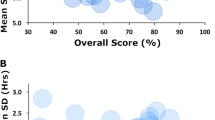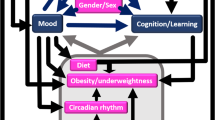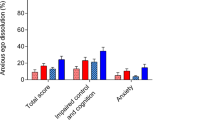Abstract
Autonomic dysfunction and sleep problems are closely associated with hypertension and predict cardiovascular morbidity and mortality. Animal studies and clinical observations have identified exercise as an important factor in preventing and treating hypertension. However, the roles of autonomic function and sleep in the antihypertensive mechanisms of exercise are still not fully understood. This study aimed to clarify the physiological mechanisms associated with autonomic function and sleep through wheel exercise. Male spontaneously hypertensive rats (SHRs) were grouped into a wheel-exercised group and a sedentary group (controls). Electroencephalogram, electromyogram, electrocardiogram, and mean arterial pressure (MAP) were recorded simultaneously for 24 h once a week over 11 weeks. Wheel exercise was initiated in the SHRs at 12 weeks old and continued for another eight weeks. A significant suppression in the age-related elevation of MAP was noted in the SHRs undergoing wheel exercise. The reduction in MAP was correlated with increased parasympathetic activity and baroreflex sensitivity and decreased sympathetic activity, mainly during quiet sleep. Exercise increased the paradoxical sleep time and theta power (associated with cognitive function) but not the delta power (an indicator of sleep depth) or the attenuation of circadian rhythm flattening (characterized by increased wakefulness and less sleep during the light period and the opposite during the dark period). Furthermore, the exercise-induced changes in autonomic function occurred before those in sleep patterns, which were dependent on each other. In conclusion, wheel exercise can modulate sleep-related cardiovascular dysfunction and the flattening of circadian rhythm, preventing the progression of hypertension, which reduces the incidence of cardiovascular diseases.
This is a preview of subscription content, access via your institution
Access options
Subscribe to this journal
Receive 12 print issues and online access
$259.00 per year
only $21.58 per issue
Buy this article
- Purchase on Springer Link
- Instant access to full article PDF
Prices may be subject to local taxes which are calculated during checkout






Similar content being viewed by others
References
Kearney PM, Whelton M, Reynolds K, Muntner P, Whelton PK, He J. Global burden of hypertension: analysis of worldwide data. Lancet 2005;365:217–23.
Baguet JP, Legallicier B, Auquier P, Robitail S. Updated meta-analytical approach to the efficacy of antihypertensive drugs in reducing blood pressure. Clin Drug Investig 2007;27:735–53.
Ross SD, Akhras KS, Zhang S, Rozinsky M, Nalysnyk L. Discontinuation of antihypertensive drugs due to adverse events: a systematic review and meta-analysis. Pharmacotherapy 2001;21:940–53.
Herrod PJJ, Doleman B, Blackwell JEM, O’Boyle F, Williams JP, Lund JN, et al. Exercise and other nonpharmacological strategies to reduce blood pressure in older adults: a systematic review and meta-analysis. J Am Soc Hypertens 2018;12:248–67.
Erdogan D, Gonul E, Icli A, Yucel H, Arslan A, Akcay S, et al. Effects of normal blood pressure, prehypertension, and hypertension on autonomic nervous system function. Int J Cardiol 2011;151:50–53.
Rodrigues B, Feriani DJ, Gambassi BB, Irigoyen MC, Angelis KD, Hélio José Júnior C. Exercise training on cardiovascular diseases: role of animal models in the elucidation of the mechanisms. Motriz: Revista de Educação Física. 2017;23:e101624.
Brum PC, Da Silva GJ, Moreira ED, Ida F, Negrao CE, Krieger EM. Exercise training increases baroreceptor gain sensitivity in normal and hypertensive rats. Hypertension 2000;36:1018–22.
DiCarlo SE, Collins HL, Rodenbaugh DW, Smitha MR, Berger RD, Yeragani VK. Daily exercise reduces measures of heart rate and blood pressure variability in hypertensive rats. Clin Exp Hypertens 2002;24:221–34.
Somers VK, Dyken ME, Mark AL, Abboud FM. Sympathetic-nerve activity during sleep in normal subjects. N. Engl J Med 1993;328:303–7.
Kuo TBJ, Yang CCH. Sleep-related changes in cardiovascular neural regulation in spontaneously hypertensive rats. Circulation 2005;112:849–54.
Stein PK, Pu Y. Heart rate variability, sleep and sleep disorders. Sleep Med Rev 2012;16:47–66.
Chennaoui M, Arnal PJ, Sauvet F, Leger D. Sleep and exercise: a reciprocal issue? Sleep Med Rev 2015;20:59–72.
Sandercock GR, Bromley PD, Brodie DA. Effects of exercise on heart rate variability: inferences from meta-analysis. Med Sci Sports Exerc 2005;37:433–9.
Hynynen E, Vesterinen V, Rusko H, Nummela A. Effects of moderate and heavy endurance exercise on nocturnal HRV. Int J Sports Med 2010;31:428–32.
Pichot V, Busso T, Roche F, Garet M, Costes F, Duverney D, et al. Autonomic adaptations to intensive and overload training periods: a laboratory study. Med Sci Sports Exerc 2002;34:1660–6.
Rossoni LV, Oliveira RA, Caffaro RR, Miana M, Sanz-Rosa D, Koike MK, et al. Cardiac benefits of exercise training in aging spontaneously hypertensive rats. J Hypertens 2011;29:2349–58.
Li JY, Chen CW, Liu TH, Kuo TBJ, Yang CCH. Exercise prevents hypertension and disrupts the correlation between vascular sympathetic activity and age-related increase in blood pressure in SHRs. Am J Hypertens 2019;32:1091–1100.
Li JY, Kuo TBJ, Yen JC, Tsai SC, Yang CCH. Voluntary and involuntary running in the rat show different patterns of theta rhythm, physical activity, and heart rate. J Neurophysiol 2014;111:2061–70.
Brown DA, Johnson MS, Armstrong CJ, Lynch JM, Caruso NM, Ehlers LB, et al. Short-term treadmill running in the rat: what kind of stressor is it? J Appl Physiol (1985). 2007;103:1979–85.
Alomari MA, Khabour OF, Alzoubi KH, Alzubi MA. Forced and voluntary exercises equally improve spatial learning and memory and hippocampal BDNF levels. Behav Brain Res 2013;247:34–39.
Burghardt PR, Fulk LJ, Hand GA, Wilson MA. The effects of chronic treadmill and wheel running on behavior in rats. Brain Res 2004;1019:84–96.
Blanco-Centurion CA, Shiromani PJ. Beneficial effects of regular exercise on sleep in old F344 rats. Neurobiol Aging 2006;27:1859–69.
Vaziri ND, Wang XQ, Ni ZN, Kivlighn S, Shahinfar S. Effects of aging and AT-1 receptor blockade on NO synthase expression and renal function in SHR. Biochim Biophys Acta 2002;1592:153–61.
Agarwal D, Haque M, Sriramula S, Mariappan N, Pariaut R, Francis J. Role of proinflammatory cytokines and redox homeostasis in exercise-induced delayed progression of hypertension in spontaneously hypertensive rats. Hypertension 2009;54:1393–1400.
Frank MK, de Mello MT, Lee KS, Daubian-Nose P, Tufik S, Esteves AM. Sleep-related movement disorder symptoms in SHR are attenuated by physical exercise and an angiotensin-converting enzyme inhibitor. Physiol Behav 2016;154:161–8.
Waldman BM, Augustyniak RA, Chen H, Rossi NF. Effects of voluntary exercise on blood pressure, angiotensin II, aldosterone, and renal function in two-kidney, one-clip hypertensive rats. Integr Blood Press Control 2017;10:41–51.
Bjorvatn B, Fagerland S, Ursin R. EEG power densities (0.5-20 Hz) in different sleep-wake stages in rats. Physiol Behav 1998;63:413–7.
Heart rate variability: standards of measurement, physiological interpretation and clinical use. Task Force of the European Society of Cardiology and the North American Society of Pacing and Electrophysiology. Circulation 1996;93:1043–65.
Kuo TBJ, Lin T, Yang CCH, Li CL, Chen CF, Chou P. Effect of aging on gender differences in neural control of heart rate. Am J Physiol 1999;277:H2233–2239.
Healy DP, Printz MP. Angiotensinogen levels in the brain and cerebrospinal fluid of the genetically hypertensive rat. Hypertension 1985;7:752–9.
Yamori Y. Development of the spontaneously hypertensive rat (SHR) and of various spontaneous rat models, and their implications. Handb hypertension 1963;4:224–39.
Sata Y, Kawada T, Shimizu S, Kamiya A, Akiyama T, Sugimachi M. Predominant role of neural arc in sympathetic baroreflex resetting of spontaneously hypertensive rats. Circ J 2015;79:592–9.
Shi L, Zhang Y, Liu Y, Gu B, Cao R, Chen Y, et al. Exercise prevents upregulation of RyRs-BKCa coupling in cerebral arterial smooth muscle cells from spontaneously hypertensive rats. Arterioscler Thromb Vasc Biol 2016;36:1607–17.
Myllymaki T, Rusko H, Syvaoja H, Juuti T, Kinnunen ML, Kyrolainen H. Effects of exercise intensity and duration on nocturnal heart rate variability and sleep quality. Eur J Appl Physiol 2012;112:801–9.
Jones H, George K, Edwards B, Atkinson G. Exercise intensity and blood pressure during sleep. Int J Sports Med 2009;30:94–99.
Thompson RS, Roller R, Greenwood BN, Fleshner M. Wheel running improves REM sleep and attenuates stress-induced flattening of diurnal rhythms in F344 rats. Stress 2016;19:312–24.
Lancel M, Droste SK, Sommer S, Reul JM. Influence of regular voluntary exercise on spontaneous and social stress-affected sleep in mice. Eur J Neurosci 2003;17:2171–9.
Lai CT, Chen CY, Kuo TBJ, Chern CM, Yang CCH. Sympathetic hyperactivity, sleep fragmentation, and wake-related blood pressure surge during late-light sleep in spontaneously hypertensive rats. Am J Hypertens 2016;29:590–7.
Sladek M, Polidarova L, Novakova M, Parkanova D, Sumova A. Early chronotype and tissue-specific alterations of circadian clock function in spontaneously hypertensive rats. PLoS One. 2012;7:e46951.
Chen CW, Kuo TBJ, Chen CY, Yang CCH. Reduced capacity of autonomic and baroreflex control associated with sleep pattern in spontaneously hypertensive rats with a nondipping profile. J Hypertens 2017;35:558–70.
Verwey M, Robinson B, Amir S. Recording and analysis of circadian rhythms in running-wheel activity in rodents. J Vis Exp. 2013;71:e50186.
Yamanaka Y, Hashimoto S, Tanahashi Y, Nishide SY, Honma S, Honma K. Physical exercise accelerates reentrainment of human sleep-wake cycle but not of plasma melatonin rhythm to 8-h phase-advanced sleep schedule. Am J Physiol Regul Integr Comp Physiol 2010;298:R681–691.
Cummins TD, Finnigan S. Theta power is reduced in healthy cognitive aging. Int J Psychophysiol 2007;66:10–17.
Olvera-Cortes E, Guevara MA, Gonzalez-Burgos I. Increase of the hippocampal theta activity in the Morris water maze reflects learning rather than motor activity. Brain Res Bull 2004;62:379–84.
Louie K, Wilson MA. Temporally structured replay of awake hippocampal ensemble activity during rapid eye movement sleep. Neuron 2001;29:145–56.
Nichol KE, Parachikova AI, Cotman CW. Three weeks of running wheel exposure improves cognitive performance in the aged Tg2576 mouse. Behav Brain Res 2007;184:124–32.
Li JY, Kuo TBJ, Hung CT, Yang CCH. Voluntary exercise enhances hippocampal theta rhythm and cognition in the rat. Behav Brain Res 2021;399:112916.
Acknowledgements
The authors take full responsibility for the experimental design and data collection, analysis, and interpretation. We thank Ms Yu-Syuan Liou for her article production support. This work was financially supported by a grant (107BRC-B506) from the Brain Research Center, National Yang Ming Chiao Tung University, from the Featured Areas Research Center Program within the framework of the Higher Education Sprout Project by the Ministry of Education in Taiwan; a grant (10601-62-012) from Taipei City Hospital; and grants (MOST 106-2314-B-010-025 and MOST 106-2627-E-010-001) from the Ministry of Science and Technology in Taiwan. The authors did not receive any other financial support from any manufacturer.
Author information
Authors and Affiliations
Corresponding author
Ethics declarations
Conflict of interest
The authors declare no competing interests.
Additional information
Publisher’s note Springer Nature remains neutral with regard to jurisdictional claims in published maps and institutional affiliations.
Supplementary information
Rights and permissions
About this article
Cite this article
Chen, CW., Kuo, T.B.J., Hsu, PC. et al. Roles of sleep-related cardiovascular autonomic functions in voluntary-exercise-induced alleviation of hypertension in spontaneously hypertensive rats. Hypertens Res 45, 1154–1167 (2022). https://doi.org/10.1038/s41440-022-00916-1
Received:
Revised:
Accepted:
Published:
Issue Date:
DOI: https://doi.org/10.1038/s41440-022-00916-1
Keywords
This article is cited by
-
2023 update and perspectives
Hypertension Research (2024)
-
Effectiveness of regular physical activity in preventing the progression of arterial hypertension: improved cardiovascular autonomic control during sleep
Hypertension Research (2022)



